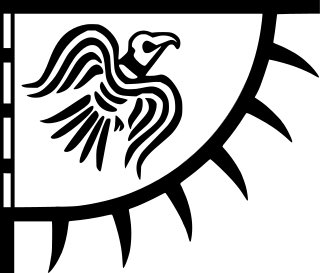
The Orkneyinga saga is a historical narrative of the history of the Orkney and Shetland islands and their relationship with other local polities, particularly Norway and Scotland. The saga has "no parallel in the social and literary record of Scotland" and is "the only medieval chronicle to have Orkney as the central place of action". The main focus of the work is the line of jarls who ruled the Earldom of Orkney, which constituted the Norðreyjar or Northern Isles of both Orkney and Shetland and there are frequent references to both archipelagoes throughout.

Saint Magnus Erlendsson, Earl of Orkney, sometimes known as Magnus the Martyr, was Earl of Orkney from 1106 to about 1115.
Malcolm II was King of the Scots from 1005 until his death. He was a son of King Kenneth II; the Prophecy of Berchán says that his mother was a woman of Leinster and refers to him as Forranach, "the Destroyer".
Einarr Rognvaldarson often referred to by his byname Torf-Einarr, was one of the Norse Earls of Orkney. The son of the Norse jarl, Rognvald Eysteinsson and a concubine, his rise to power is related in sagas which apparently draw on verses of Einarr's own composition for inspiration. After battling for control of the Northern Isles of Scotland and a struggle with Norwegian royalty, Einarr founded a dynasty which retained control of the islands for centuries after his death.
Thorfinn Torf-Einarsson also known as Thorfinn Skull-splitter was a 10th-century Earl of Orkney. He appears in the Orkneyinga saga and briefly in St Olaf's Saga, as incorporated into the Heimskringla. These stories were first written down in Iceland in the early 13th century and much of the information they contain is "hard to corroborate".
Thorfinn Sigurdsson, also known as Thorfinn the Mighty, was an 11th-century Earl of Orkney. He was the youngest of five sons of Earl Sigurd Hlodvirsson and the only one resulting from Sigurd's marriage to a daughter of Malcolm II of Scotland. He ruled alone as earl for about a third of the time that he held the title and jointly with one or more of his brothers or with his nephew Rögnvald Brusason for the remainder. Thorfinn married Ingibiorg Finnsdottir, daughter of Finn Arnesson, Jarl of Halland.
Sigurd Hlodvirsson, popularly known as Sigurd the Stout from the Old Norse Sigurðr digri, was an Earl of Orkney. The main sources for his life are the Norse Sagas, which were first written down some two centuries or more after his death. These engaging stories must therefore be treated with caution rather than as reliable historical documents.

Harald Maddadsson was Earl of Orkney and Mormaer of Caithness from 1139 until 1206. He was the son of Matad, Mormaer of Atholl, and Margaret, daughter of Earl Haakon Paulsson of Orkney. Of mixed Norse and Gaelic blood, and a descendant of Scots kings, he was a significant figure in northern Scotland, and played a prominent part in Scottish politics of the twelfth century. The Orkneyinga Saga names him one of the three most powerful Earls of Orkney along with Sigurd Eysteinsson and Thorfinn Sigurdsson.
Ingibiorg Finnsdottir was a daughter of Earl Finn Arnesson and Bergljot Halvdansdottir. She was also a niece of the Norwegian Kings Saint Olaf and Harald Hardraade. She is also known as Ingibiorg, the Earls'-Mother. The dates of her life are not known with certainty.

The Mormaer of Caithness was a vassal title mostly held by members of the Norwegian nobility based in Orkney from the Viking Age until 1350. The mormaerdom was held as fief of Scotland and the title was frequently held by the Norse Earls of Orkney, who were thus a vassal of both the King of Norway and the King of Scots. There is no other example in the history of either Norway or of Scotland in which a dynasty of earls owed their allegiance to two different kings.
Einar Sigurdsson, also called Einarr rangmunnr Sigurðarson or Einar Wry-Mouth, was a son of Sigurd Hlodvirsson. He was jointly Earl of Orkney from 1014. His life is recorded in the Orkneyinga Saga.
Rognvald Brusason , son of Brusi Sigurdsson, was Earl of Orkney jointly with Thorfinn Sigurdsson from about 1037 onwards. His life is recorded in the Orkneyinga Saga.
Paul Thorfinnsson and Erlend Thorfinnsson were brothers who ruled together as Earls of Orkney. Paul and Erlend were the sons of Thorfinn Sigurdsson and Ingibiorg Finnsdottir. Through Ingibiorg's father Finn Arnesson and his wife, the family was related to the Norwegian Kings Olav II and Harald II. They are both described as "tall, handsome men, shrewd and gentle, taking rather more after their mother's side of the family. Their lives and times are recounted in the Orkneyinga Saga, which was first written down in the early 13th century by an unknown Icelandic author.
Haakon Paulsson was a Norwegian Jarl (1105–1123) and jointly ruled the Earldom of Orkney with his cousin Magnus Erlendsson. Their lives and times are recounted in the Orkneyinga Saga, which was first written down in the early 13th century by an unknown Icelandic author.
Karl Hundason, also Karl Hundisson, is a personage in the Orkneyinga Saga. The saga recounts a war between Thorfinn Sigurdsson, Earl of Orkney, and Karl, whom it calls king of Scots. The question of his identity and historicity has been debated by historians of Scotland and the Northern Isles for more than a century. However a literal translation suggests that the name may simply be an insult.
Ragnhild Eriksdotter was the daughter of Eric Bloodaxe and his wife, Gunnhild. According to the Orkneyinga Saga, she was an ambitious and scheming woman who sought power through the men of the family of Thorfinn Torf-Einarsson, who was Earl of Orkney. The period after Thorfinn's death was one of dynastic strife.
Sigurdsson is a surname of Norwegian origin, meaning son of Sigurd. The name refers to:
Helga Moddansdóttir was the mistress of Haakon Paulsson who was Earl of Orkney from 1105–1123.







